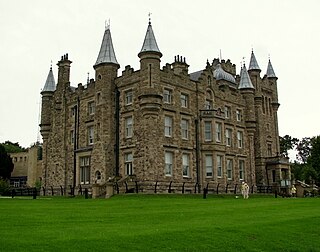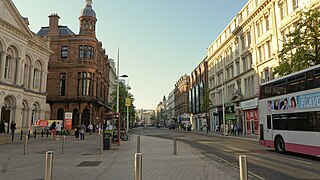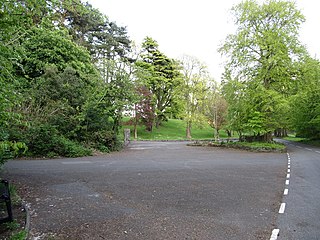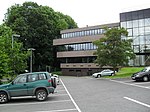
The Parliament of Northern Ireland was the home rule legislature of Northern Ireland, created under the Government of Ireland Act 1920, which sat from 7 June 1921 to 30 March 1972, when it was suspended because of its inability to restore order during the Troubles, resulting in the introduction of direct rule. It was abolished under the Northern Ireland Constitution Act 1973.

In the United Kingdom, a listed building is a structure of particular architectural and/or historic interest deserving of special protection. Such buildings are placed on one of the four statutory lists maintained by Historic England in England, Historic Environment Scotland in Scotland, Cadw in Wales, and the Northern Ireland Environment Agency in Northern Ireland. The classification schemes differ between England and Wales, Scotland, and Northern Ireland. The term has also been used in the Republic of Ireland, where buildings are protected under the Planning and Development Act 2000, although the statutory term in Ireland is "protected structure".

The Northern Ireland Assembly, often referred to by the metonym Stormont, is the devolved legislature of Northern Ireland. It has power to legislate in a wide range of areas that are not explicitly reserved to the Parliament of the United Kingdom, and to appoint the Northern Ireland Executive. It sits at Parliament Buildings at Stormont in Belfast.
The Northern Ireland Executive is the devolved government of Northern Ireland, an administrative branch of the legislature – the Northern Ireland Assembly, situated in Belfast. It is answerable to the assembly and was initially established according to the terms of the Northern Ireland Act 1998, which followed the Good Friday Agreement. The executive is referred to in the legislation as the Executive Committee of the assembly and is an example of consociationalist ("power-sharing") government.

Stormont Castle is a manor house on the Stormont Estate in east Belfast which is home to the Northern Ireland Executive and the Executive Office. It is a Grade A listed building.

Parliament Buildings, often referred to as Stormont, because of its location in the Stormont Estate area of Belfast, is the seat of the Northern Ireland Assembly, the devolved legislature for Northern Ireland. The purpose-built building, designed by Arnold Thornely, and constructed by Stewart & Partners, was opened by Edward, Prince of Wales, in 1932.

James Hugh Allister is a Northern Irish politician and barrister who has served as Member of Parliament (MP) for North Antrim since the 2024 general election. He founded the Traditional Unionist Voice (TUV) in 2007 and has led the party since its formation. Prior to his election to Westminster, Allister was a member of the Legislative Assembly (MLA) for North Antrim, having been first elected in the 2011 Assembly election.

Stormont House is a Grade B1 listed building situated in the Stormont Estate in Belfast, Northern Ireland. It was designed by Ralph Knott, although Sir Edwin Lutyens has been credited with some involvement.

Dundonald is a large settlement and civil parish in County Down, Northern Ireland, United Kingdom. It lies east of Belfast and is often considered a suburb of the city. It is home to the Ulster Hospital, Dundonald International Ice Bowl, Dundonald Omnipark, has a Park and Ride facility for the Glider, access to the Comber Greenway and several housing developments. John de Courcey established a keep including a motte-and-bailey in the 12th century. This is known as Moat Park and can be accessed from Church Green, Comber Road and the Upper Newtownards Road.

The economy of Northern Ireland is the smallest of the four constituents of the United Kingdom and the smaller of the two jurisdictions on the island of Ireland. At the time of the Partition of Ireland in 1922, and for a period afterwards, Northern Ireland had a predominantly industrial economy, most notably in shipbuilding, rope manufacture and textiles, but most heavy industry has since been replaced by services. Northern Ireland's economy has strong links to the economies of the Republic of Ireland and Great Britain.

Gosford Castle is a 19th-century country house situated in Gosford, a townland of Markethill, County Armagh, Northern Ireland. It was built for Archibald Acheson, 2nd Earl of Gosford, and designed in the Norman revival style by London architect Thomas Hopper. It is a Grade A listed building, and is said to be Ulster's largest. The Earls of Gosford occupied the castle until 1921, and the estate was later purchased by the Ministry of Agriculture to form Gosford Forest Park. The building subsequently deteriorated and in 2006 was sold to a development company who converted the castle into private dwellings.
Health and Social Care is the publicly funded healthcare system in Northern Ireland. Although having been created separately to the National Health Service (NHS), it is nonetheless considered a part of the overall national health service in the United Kingdom. The Northern Ireland Executive through its Department of Health is responsible for its funding, while the Public Health Agency is the executive agency responsible for the provision of public health and social care services across Northern Ireland. It is free of charge to all citizens of Northern Ireland and the rest of the United Kingdom.

Dundonald House is a government building in Belfast, Northern Ireland. Built in 1962 it housed the Department of Agriculture and Rural Development, the Geological Survey of Northern Ireland and the Northern Ireland Prison Service until 2023 when the building closed on safety grounds. It is a grade B+ listed building and survived an application for its demolition in 2024.

The Ulster Hospital, commonly known as the Ulster, is a teaching hospital in Dundonald in County Down, Northern Ireland. It is within the townland of Ballyregan, beside the A20 road. It provides acute services in the North Down, Ards and Castlereagh council areas, as well as east Belfast. It is managed by the South Eastern Health and Social Care Trust.
Netherleigh House, is a Government Building in Belfast, Northern Ireland which serves as the headquarters for the Department for the Economy, Northern Ireland and the offices of the minister for that department.

The Third Executive was, under the terms of the Northern Ireland Act 1998, a power-sharing coalition.

Glider is a bus rapid transit system in Belfast, Northern Ireland, designed to improve the efficiency of mass transit in the city by connecting East and West Belfast and the Titanic Quarter via the city centre. The service is operated by Translink.

Matthew John O'Toole MLA is an Irish nationalist politician, former civil servant, and journalist, serving as leader of the Social Democratic and Labour Party (SDLP) in the Northern Ireland Assembly and leader of the opposition since 2022, and a Member of the Northern Ireland Assembly (MLA) for Belfast South since 2020.

Fernhill House is a grade B2 listed building in Glencairn Road, Belfast. It was built in 1864 for the local butter merchant John Smith, with outbuildings added to the north in 1880. It was sold by Smith's family to businessman Samuel Cunningham in 1898. He was a staunch unionist who used the grounds to train members of the Ulster Volunteer Force and to store weapons during the 1912 Home Rule Crisis. Cunningham also kept racing horses in the house's stables, including Tipperary Tim, which won the 1928 Grand National. The estate was purchased by the Belfast Corporation in 1962 and opened to the public as Glencairn Park. The house housed the municipal parks department between 1975 and 1990. Fernhill House was selected by the Combined Loyalist Military Command as the site for their 1994 ceasefire declaration, which presaged the 1998 Good Friday Agreement. From 1996 to 2008 the building housed a museum exhibiting items of local history, Ulster's military history and relating to the Orange Order. The building has since stood vacant and is listed as being at risk. The building and outbuildings were separately granted listed building protection in 2016.

A Northern Ireland Assembly election will be held to elect 90 members to the Northern Ireland Assembly on or before 6 May 2027.

























